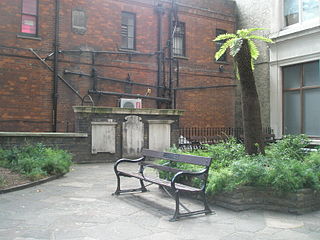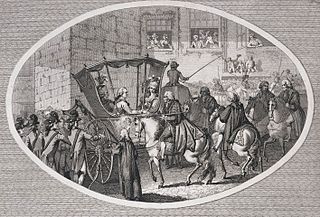Related Research Articles
William Donald Dennison was a Canadian social-democratic politician that served in both the Ontario Legislative Assembly and finally as the City of Toronto's mayor. He served two nonconsecutive terms as a Member of Provincial Parliament (MPP) in the 1940s and early 1950s. After his provincial-level career, he focused on Toronto's municipal politics, holding offices as an alderman, member of the Toronto Board of Control, and finally as the city's mayor. He was the mayor from 1967 to 1972, winning two consecutive three-year terms. Prior to entering politics, he was a school principal and teacher. As of 2022, he was the last mayor of Toronto to be a member of the Orange Order.

William Wyggeston was an English wool merchant based in Leicester. He was part of the Wyggeston family, which included at least one other William Wyggeston.

Farringdon Without is the most westerly Ward of the City of London, its suffix Without reflects its origin as lying beyond the City's former defensive walls. It was first established in 1394 to administer the suburbs west of Ludgate and Newgate, and also around West Smithfield. This was achieved by splitting the very large, pre-existing Farringdon Ward into two parts, Farringdon Within and Farringdon Without. The large and prosperous extramural suburb of Farringdon Without has been described as having been London's first West End.

Sir Charles Duncombe of Teddington, Middlesex and Barford, Wiltshire, was an English banker and Tory politician who sat in the English and British House of Commons between 1685 and 1711. He served as Lord Mayor of London from 1708 to 1709. He made a fortune in banking and was said to be worth £400,000 later in life, and the richest commoner in England on his death.

St Peter, Westcheap, also called "St Peter Cheap", "St Peter at the Cross in Cheap", or "Ecclesia S. Petri de Wodestreet", was a parish and parish church of medieval origins in the City of London. The church stood at the south-west corner of Wood Street where it opens onto Cheapside, directly facing the old Cheapside Cross. In its heyday it was a familiar landmark where the City waits used to stand on the roof and play as the great processions went past. It was destroyed in the Great Fire of London in 1666, together with most of its surroundings, and was never rebuilt.

William Barlum Thompson was the Mayor of Detroit from 1907 to 1908 and again from 1911 to 1912.

Sir Martin Bowes was a very prominent and active civic dignitary of Tudor London whose career continued through the reigns of Henry VIII, Edward VI, Mary I and Elizabeth I. Born into the citizenry of York, Bowes was apprenticed in London and made his career at the Royal Mint, as a master-worker and under-treasurer, and personally implemented the debasement of English currency which became a fiscal imperative in the later reign of Henry.
Robert Alanson of Lincoln, England was an English Member of Parliament.
Sir Francis Child (1642–1713), of Hollybush House, Fulham, Middlesex and the Marygold by Temple Bar, London, was an English banker and politician who sat in the English and British House of Commons between 1698 and 1713. He served as Lord Mayor of London for the year 1698 to 1699. The goldsmith's business which he built up from 1671 later became one of the first London banks, Child & Co.
Sir John Crosby was a London merchant and alderman, diplomat and Member of Parliament. A Yorkist during the Wars of the Roses, he was knighted for his service in resisting an attack on London in 1471 by Lancastrian forces under Thomas Fauconberg. Crosby Hall, the mansion he built at Bishopsgate, was later moved to Chelsea, where it still survives.
Nicholas de Farndone was a 14th-century English goldsmith and politician who served four non-consecutive terms as Mayor of London.
Andrew Aubrey was an English merchant and politician, who served three terms as Lord Mayor of London during the reign of Edward III.

William Pickett was an English goldsmith and local politician, Lord Mayor of London in 1789.
George Gale was Member of Parliament for York during the Parliaments of Henry VIII, notably the Reformation Parliament, and of Edward VI. He also held several important offices in the city of York and was the Great Great Grandfather of the antiquarian, Thomas Gale.
Gregory's Chronicle, the Chronicle of London, or MS Edgerton 1995, is the name given to a fifteenth-century English chronicle. It takes its name from its supposed author, William Gregory, who started as a skinner in London and went on to become a London Alderman, Sheriff from 1436 to 1437, and eventually Mayor from 1450 to 1451. The name 'Gregory' for the manuscript is, however, merely a convenience, as its actual authorship is unknown. Indeed, since the chronicle spans the period 1189 to 1470, and William Gregory died in 1467, it is impossible for him to have composed it in its entirety. Other fifteenth-century authors have been proposed, ranging from a contemporary poet to an Ecclesiast, but since even the exact dates of its composition are also debated it has been impossible for historians to definitively attribute the authorship to any known individual.
Sir Bartholomew Reade was an English goldsmith and politician who served as Lord Mayor of London.
Adam Bamme was an English goldsmith and politician who served two non-consecutive terms as Lord Mayor of London in the 14th century.
Sir William Lewen, of Ewell, Surrey, was a British merchant and Tory politician who sat in the House of Commons between 1708 and 1722. He was Lord Mayor of London in 1717.
John Hogeson was one of two members of the Parliament of England for the constituency of York on two occasions between 1539 and 1542 and from 1542 to 1547.
Sir George Lawson was one of two Members of the Parliament of England for the constituency of York on two occasions from 1529 to 1533 and from 1533 to 1536.
References
- 1 2 3 Wedgwood, Josiah C. (1936). History Of Parliament (1439-1509). p. 779.